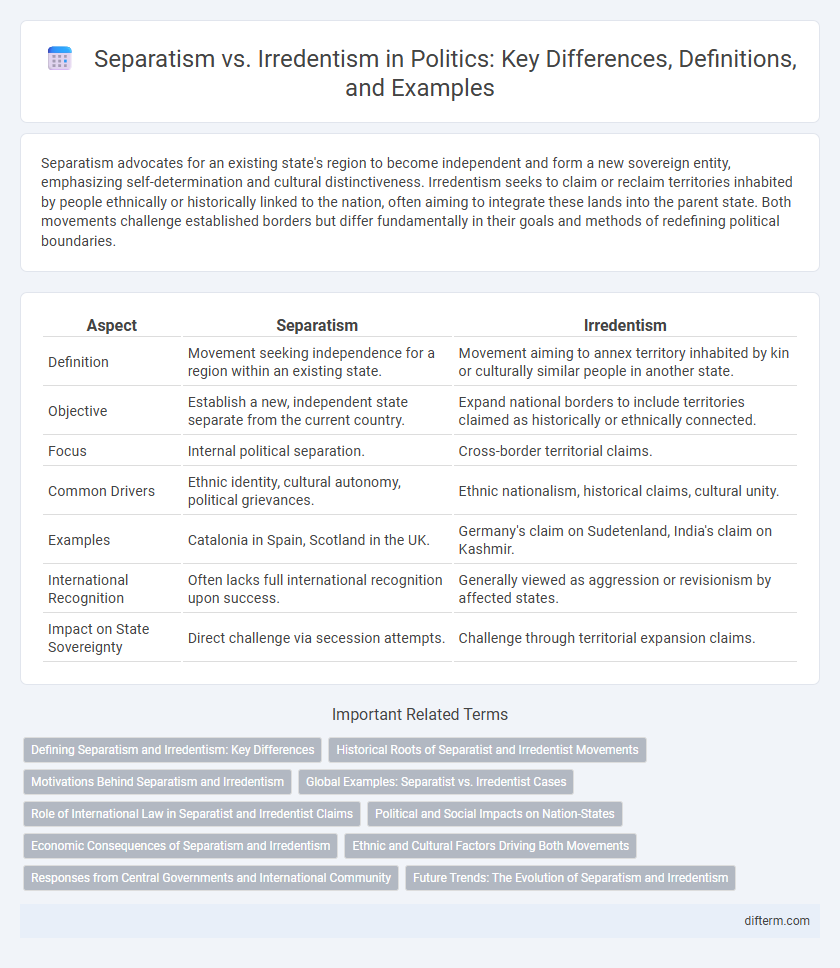Separatism advocates for an existing state's region to become independent and form a new sovereign entity, emphasizing self-determination and cultural distinctiveness. Irredentism seeks to claim or reclaim territories inhabited by people ethnically or historically linked to the nation, often aiming to integrate these lands into the parent state. Both movements challenge established borders but differ fundamentally in their goals and methods of redefining political boundaries.
Table of Comparison
| Aspect | Separatism | Irredentism |
|---|---|---|
| Definition | Movement seeking independence for a region within an existing state. | Movement aiming to annex territory inhabited by kin or culturally similar people in another state. |
| Objective | Establish a new, independent state separate from the current country. | Expand national borders to include territories claimed as historically or ethnically connected. |
| Focus | Internal political separation. | Cross-border territorial claims. |
| Common Drivers | Ethnic identity, cultural autonomy, political grievances. | Ethnic nationalism, historical claims, cultural unity. |
| Examples | Catalonia in Spain, Scotland in the UK. | Germany's claim on Sudetenland, India's claim on Kashmir. |
| International Recognition | Often lacks full international recognition upon success. | Generally viewed as aggression or revisionism by affected states. |
| Impact on State Sovereignty | Direct challenge via secession attempts. | Challenge through territorial expansion claims. |
Defining Separatism and Irredentism: Key Differences
Separatism involves a group seeking independence and sovereignty to form a new state within an existing country's territory, often driven by ethnic, cultural, or linguistic identity. Irredentism, by contrast, aims to reclaim and incorporate territories perceived as lost or rightfully belonging to the group's nation, typically emphasizing historical or ethnic ties across borders. The key distinction lies in separatism's pursuit of new statehood versus irredentism's goal of territorial integration into an existing nation-state.
Historical Roots of Separatist and Irredentist Movements
Separatist and irredentist movements trace their historical roots to ethnic, cultural, and territorial claims dating back centuries, often shaped by colonial borders and imperial legacies. Key examples include the Basque separatists in Spain, whose identity and political struggles stem from distinct linguistic and cultural heritage, and the irredentist ambitions in the Balkans aligned with shifting sovereignties after the Ottoman Empire's decline. The historical grievances embedded in these movements highlight contested nationhood and territorial reconfiguration as central themes in global politics.
Motivations Behind Separatism and Irredentism
Separatism is primarily motivated by a group's desire for political autonomy, cultural preservation, or economic control within an existing state, often fueled by perceived oppression or marginalization. Irredentism drives movements that seek to reclaim or annex territories based on historical, ethnic, or linguistic ties, emphasizing the restoration of a perceived rightful homeland. Both ideologies rely heavily on collective identity and historical narratives to justify demands for political reconfiguration.
Global Examples: Separatist vs. Irredentist Cases
Separatist movements such as Catalonia in Spain seek independence based on distinct cultural or linguistic identity, while irredentist claims like Russia's annexation of Crimea involve reclaiming territory perceived as historically or ethnically linked to the state. Examples of separatism include the Kurdish quest for autonomy across Turkey, Iraq, Syria, and Iran, contrasted with irredentism seen in Hungary's claims on parts of Romania and Slovakia. Understanding these cases reveals how self-determination and national unity drive differing geopolitical conflicts worldwide.
Role of International Law in Separatist and Irredentist Claims
International law plays a crucial role in adjudicating separatist and irredentist claims by emphasizing principles such as territorial integrity and self-determination. The United Nations Charter and related treaties often uphold existing state boundaries while recognizing the right of peoples to self-determination under specific conditions. Legal frameworks tend to restrict unilateral secession without consent, complicating separatist movements, whereas irredentist claims frequently face challenges due to the emphasis on respecting sovereign borders.
Political and Social Impacts on Nation-States
Separatism challenges the territorial integrity of nation-states by advocating for the creation of independent states within existing boundaries, often leading to social fragmentation and political instability. Irredentism seeks to reclaim lost or culturally affiliated territories, intensifying nationalist sentiments and exacerbating cross-border conflicts. Both movements disrupt national unity, complicate governance, and strain diplomatic relations, thereby influencing domestic policies and international order.
Economic Consequences of Separatism and Irredentism
Separatism can destabilize local economies by disrupting trade, investment, and labor markets, often resulting in reduced economic growth and increased uncertainty. Irredentism tends to provoke international tensions and sanctions that hinder cross-border economic cooperation and damage regional development. Both phenomena can lead to resource allocation inefficiencies and undermine investor confidence, thereby weakening overall economic stability.
Ethnic and Cultural Factors Driving Both Movements
Ethnic and cultural identity profoundly shape both separatism and irredentism, as communities seek political realignment to preserve linguistic, religious, or traditional heritage. Separatism emerges when distinct ethnic groups pursue autonomy or independence within existing states due to perceived marginalization. Irredentism involves claims to territories inhabited by culturally similar populations, aiming to unify fractured ethno-cultural regions under a single national authority.
Responses from Central Governments and International Community
Central governments typically respond to separatism with measures such as increased security enforcement, negotiation attempts, and legal restrictions to preserve national sovereignty. The international community often emphasizes respect for existing borders while promoting dialogue and peaceful conflict resolution, sometimes imposing sanctions or facilitating mediation to prevent escalation. Both actors balance maintaining territorial integrity with addressing underlying political and ethnic grievances to avoid long-term instability.
Future Trends: The Evolution of Separatism and Irredentism
Future trends in separatism and irredentism suggest a shift towards digital mobilization, where social media platforms enable rapid dissemination of nationalist narratives and facilitate cross-border solidarity among ethnic groups. Increasing geopolitical instability and resource competition will likely intensify territorial disputes, fueling both separatist movements seeking autonomy and irredentist claims aiming to redraw state boundaries. Advances in surveillance technology and international diplomacy mechanisms may alter the efficacy and tactics of these movements, driving a complex evolution in their political strategies.
separatism vs irredentism Infographic

 difterm.com
difterm.com